- MathNotebook
- MathConcepts
- StudyMath
- Geometry
- Logic
- Bott periodicity
- CategoryTheory
- FieldWithOneElement
- MathDiscovery
- Math Connections
Epistemology
- m a t h 4 w i s d o m - g m a i l
- +370 607 27 665
- My work is in the Public Domain for all to share freely.
- 读物 书 影片 维基百科
Introduction E9F5FC
Questions FFFFC0
Software
Presented on October 20, 2017, at PurplSoc, Krems, Austria.
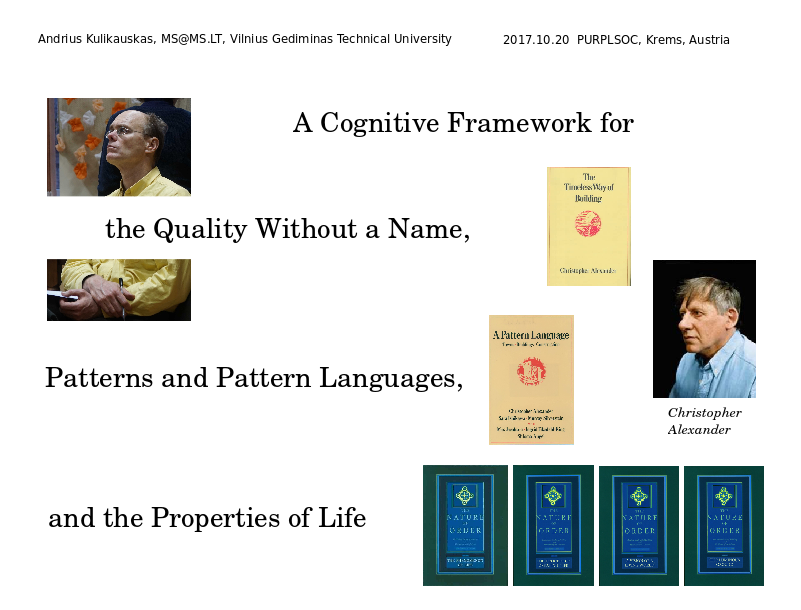
Christopher Alexander has explored three different ways in which our sense of peace (or wholeness) is a guide to creating loving environments (which support life). I present evidence for a cognitive framework that can ground and relate
- the Quality Without a Name
- patterns and pattern languages
- and 15 properties of life.
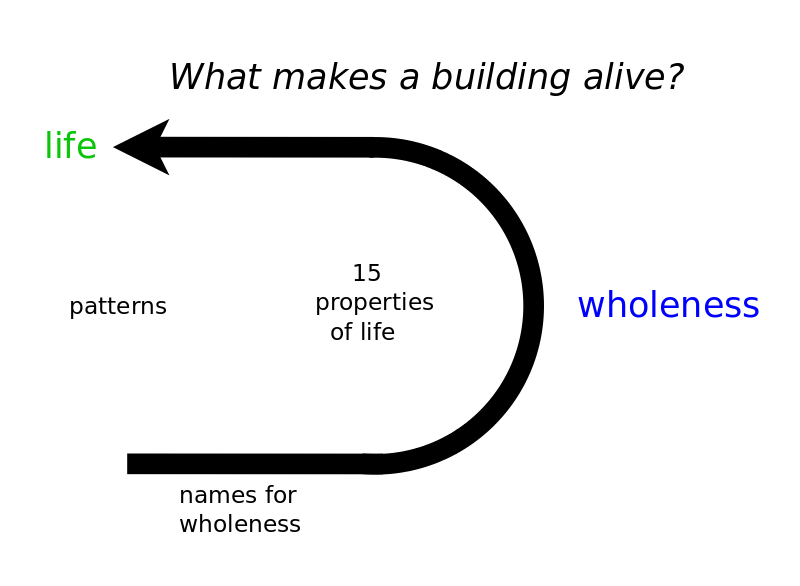
I will note investigations which we can do to clarify the various pieces of this puzzle and how they fit together. Alexander's ideas arose from his question, What makes a building alive?
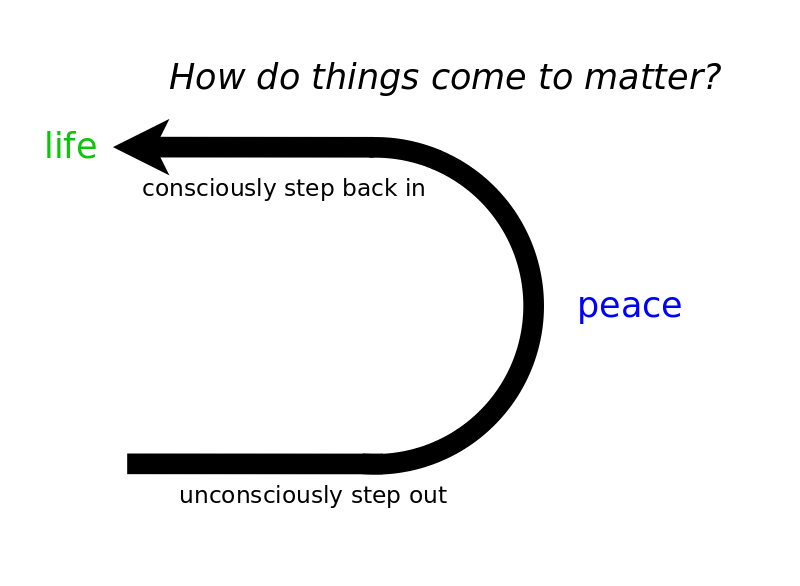
I will try to understand his findings in terms of my own question, How do things come to matter? I am finding that what matters is first defined unconsciously by our emotional life. We feel tensions in the world and must step out and above them into peace. We can then ourselves consciously define what matters with a structure which supports that peace as we step back into our world.
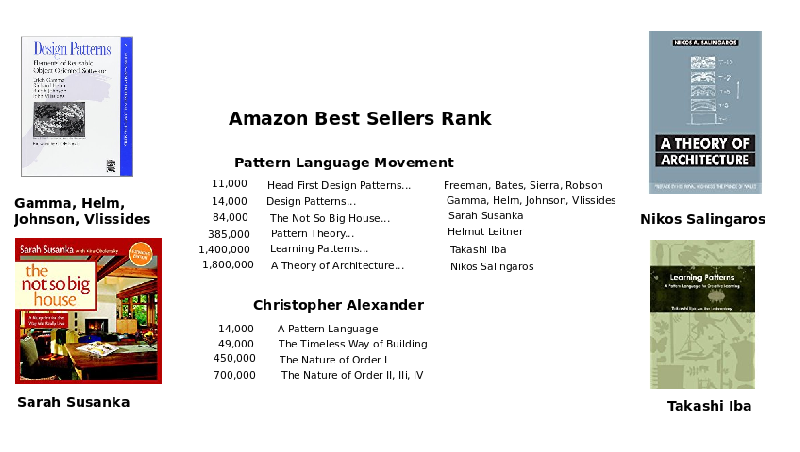
The design pattern, extreme programming and agile software movements are applying Alexander's insights. Architect Sarah Susanka is communicating them to remodelers with her book series, "The Not So Big House". Nikos Salingaros has distilled three architectural principles for maximizing distinguishibility: minimize entropy, alternate atoms and separate levels of scale by a factor of e=2.718. Takashi Iba is investigating themes such as recurring activity and properties of life which I applaud as essential in furthering a scientific approach.
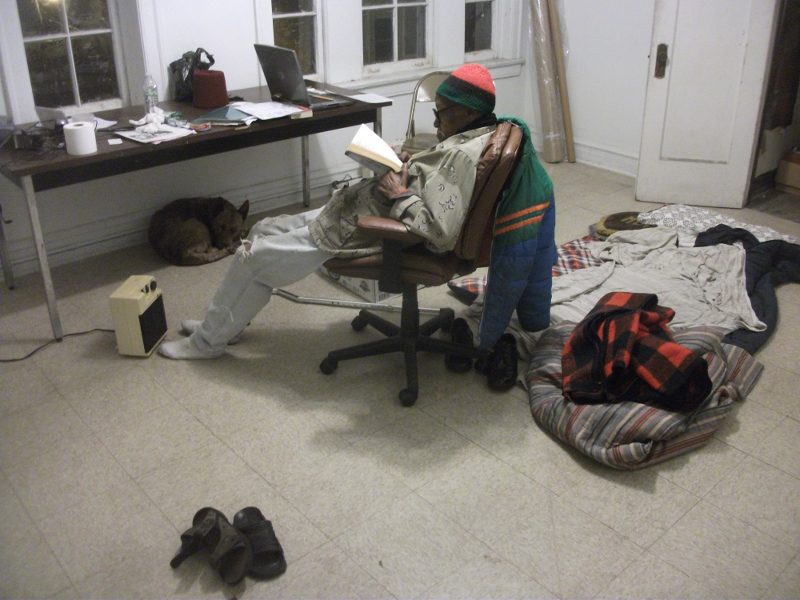
Metaphysically, the idea in Alexander's work which has him rank with Plato and Kant is that recurring activity evokes structure, and structure channels activity. Here my friend David Ellison-Bey illustrates this as he makes himself comfortable after losing his home. He warms his feet while he reads. His tissue for his tears and sniffles is within reach. Even his dog Dragonlady has found her place under the table.
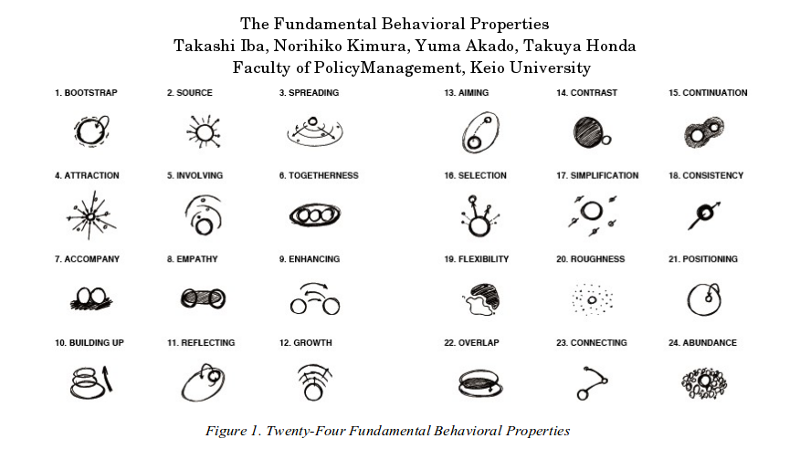
Recurring activity evokes structure. This is what makes patterns work. Therefore we should comprehensively describe all of the recurring activity for individuals, families and communities. Just as biologists document ethograms for animals, inventories of their behavior, we should likewise document human ethograms. Scientifically, it makes sense to focus on people in minimal circumstances so as to discover simple changes that make their lives more comfortable. Takashi Iba and his colleagues are leading the way in collecting human activities.
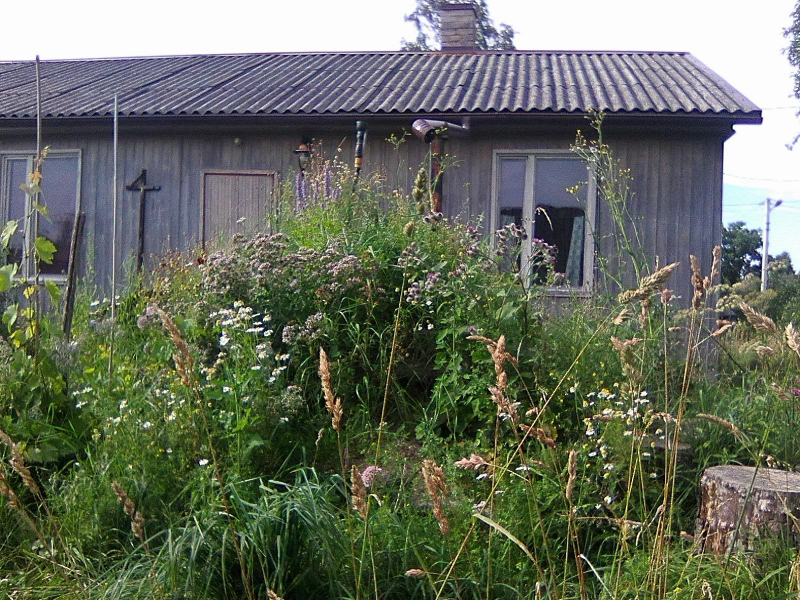
Structure channels activity. This is why we apply patterns. In my garden I have an herb spiral based on a pattern in the permaculture book Gaia's garden. The herbs are close to my house and so they draw me to forage for my lunch. I feel good to see butterflies, bumblebees, beetles and lizards. I accentuate the sunny side with sandy soil and the shady side with mulch to support a variety of plants. Another pattern, an overhanging gutter, drops rain water from the roof onto the shady side.
Scientifically, permaculture patterns are important for analyzing personal and social sustainability, whether alleged patterns truly work or not. I personally wish to contribute a metaphysics which defines concepts rigorously by showing how they fit into cognitive frameworks which structure our abstract powers of imagination.
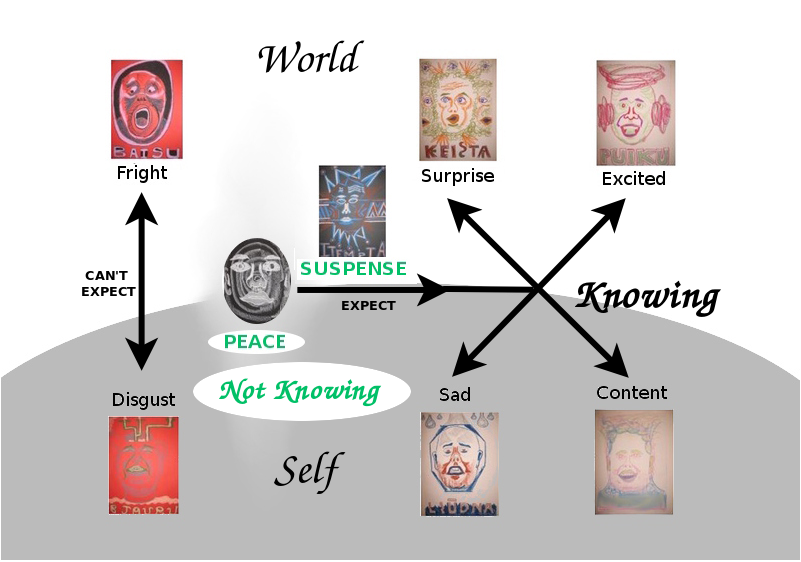
I will start with Alexander's sense of wholeness, what he has called "the quality without a name". He has done experiments to show that, given two environments, objects or photos, different people generally agree on which has more of this quality. This objectivity should be examined further. But also, this quality should be defined more rigorously.
I interpret this quality as peace, the center of our emotional life. I am at peace when I have no expectations. When I do have expectations, and they are not met, then I may be surprised if they are not met, and excited if they are. Yet if the matter is important to me, then I will be sad if they are not met, and happy if they are. I am frightened when I can't make expectations about what is beyond me because it is too sudden or strange or undesirable, and likewise I am disgusted if I can't make expectations about what is within me. So our emotional life establishes a strong boundary between our self and our world, what matters more and what matters less, what we know very well and what we don't know as well. It is also a boundary between our unconscious, whose expectations make us happy or sad, and our conscious, whose expectations make us excited or surprised. For if my loved one is ill, I may consciously expect them to die, but my unconscious expects them to live and so I am sad if they die. Our emotional life is the way that our unconscious gives feedback to our conscious regarding our expectations.
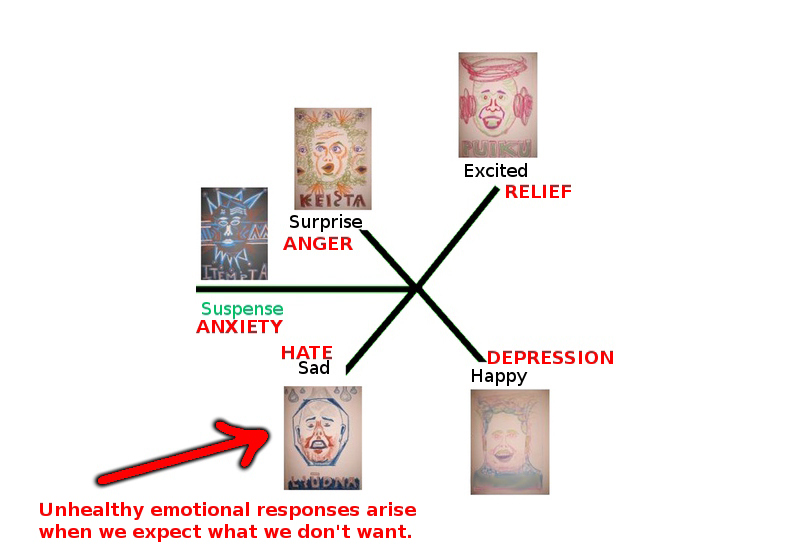
Peace, or as Alexander calls it, our sense of wholeness, has us be ready to learn from any emotion, whereas happiness is merely a symptom that our expectations have been met. If I manipulate my expectations, and expect what I don't desire, then I will have unhealthy emotions. If I expect that my bicycle will be stolen, then I won't feel surprised if it is, but rather I will feel angry or even hate, and if it is not stolen, then I will feel relieved or even depressed, and in the meanwhile I feel anxious rather than in suspense. Whereas I feel love as the impossibility of hate. Likewise, if there is nothing outside of me, then fright is impossible, and instead I feel intimacy. And if there is nothing inside of me, if I have no self, then disgust is impossible, and instead I feel beauty.
Our emotional life is thus our guide as to whether patterns are working or not. I feel riled when things are not as I expect they should be. My unconscious - my self - my accumulated knowledge - clings to how things are when I am sad or happy. In order to improve my self, my boundary with the world, I need to let go of my self. I put distance on my self by living consciously. Indeed, I live rationally when my own self does not sway me. And I am at peace when my sense of self vanishes.
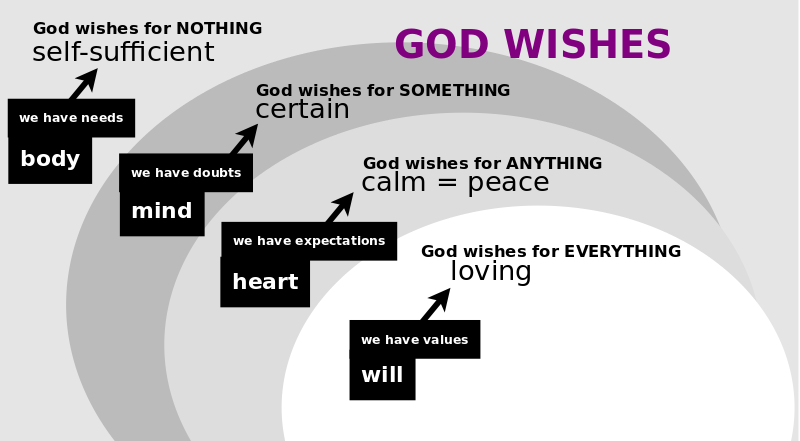
I imagine God in order to make sense of peace. God wishes for anything, is at peace, whereas we have hearts with expectations and feelings. Similarly, God wishes for nothing, is self-sufficient, whereas we have bodies with needs. God wishes for something, is certain, whereas we have minds with doubts. God wishes for everything, even our nonsensical frivolity, God is loving, whereas we of ourselves are not loving, but have wills focused on values.
But God does not have to be loving. Life is the fact that God is good, but eternal life is understanding that God does not have to be good, life does not have to be fair. And so we live in a world of agitation where so many things are not right. We can yet embrace this world, be sensitive to it, and aspire to be loving ourselves. And to be so we may listen for a God of peace, even if we don't have a God of love.
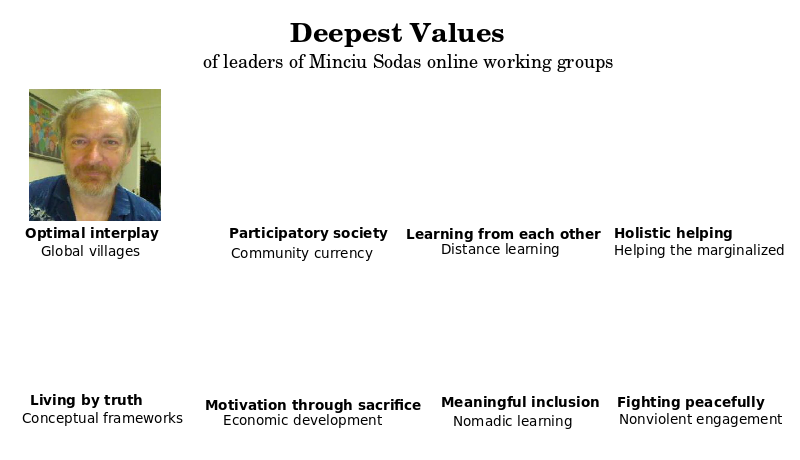
Inside each of us there is a stillness, our own spiritual center, which approximates that peace. In organizing my online laboratory, Minciu Sodas, I discovered each of our leaders to have their own unique deepest value in life which included all of their other values. In teaching ethics, I am realizing that this deepest value arises in my students as their personal reason why they should do what they should do.
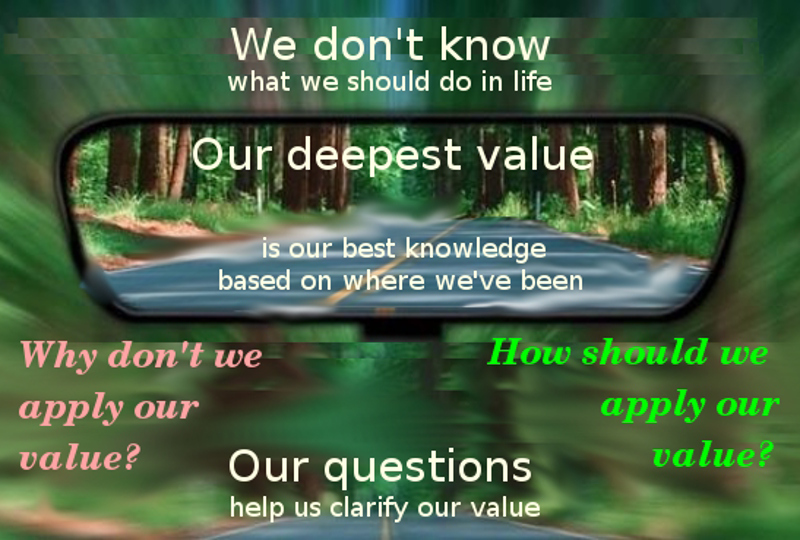
Throughout our lives, our deepest value does not change dramatically but rather grows steadily clearer. It is the sum of what we know. We are creatures of knowing, but God is an investigator, a spirit of not knowing. And so we don't know why we are here, what we should be doing. Our deepest value is simply our best approximation. And the questions we ask in life seek to clarify our value: How should we apply it? Why don't we apply it? Indeed, these are the questions in life that come to matter when we take them up with a feeling of peace.
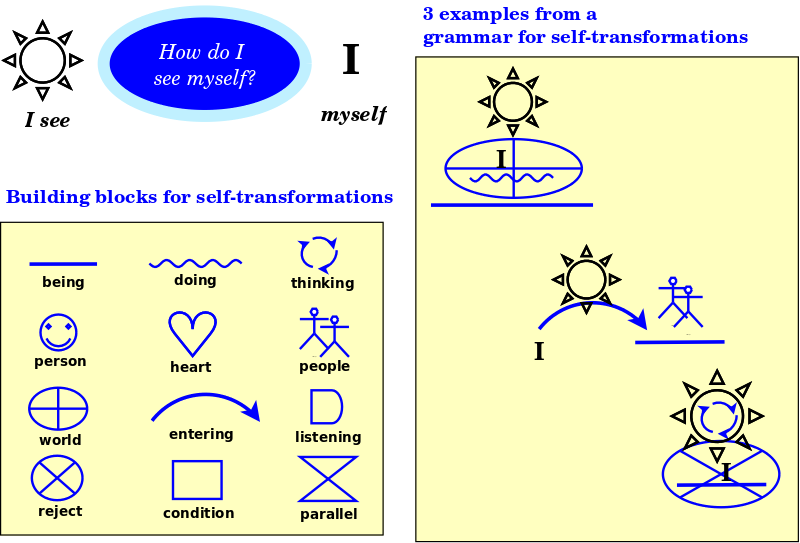
Alexander ultimately concludes that there is a single fundamental transformation underlying all of life. An intuitive way to investigate that is to study episodes in life where our own self-identity changed. I led such a workshop and preliminary results suggest that there are 12 building blocks for transformations of our self-identity.
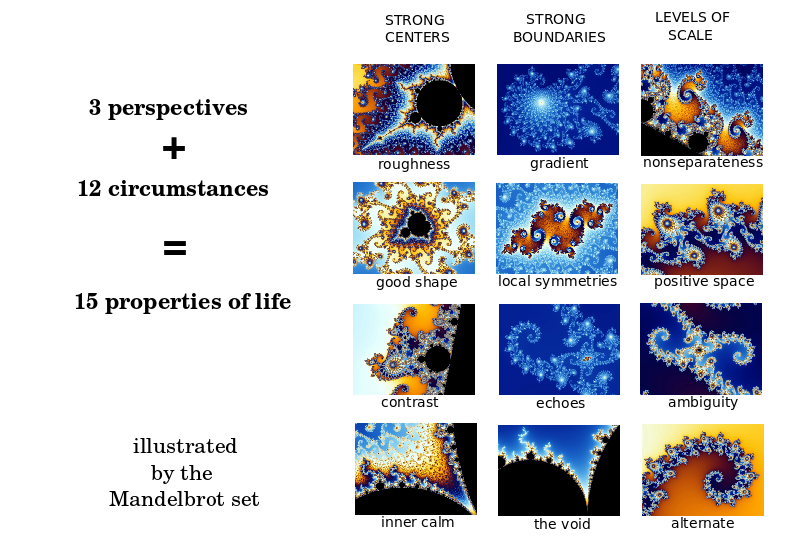
Alexander draws on his personal intuition to describe the process of life in terms of 15 transformations which he calls the properties of life. He doesn't claim there are exactly 15 properties, and Helmut Leitner adds a 16th, mutuality. I will argue in terms of cognitive structures that Alexander's intuition is basically correct and comprehensive. I will distinguish three of the properties - strong centers, strong boundaries, levels of scale - and account for the other 12 separately.
I rely on the Mandelbrot set, an endlessly intricate mathematical structure, for the sake of illustrating these properties. A separate investigation of the Mandelbrot set could show how to define these properties as mathematically real.
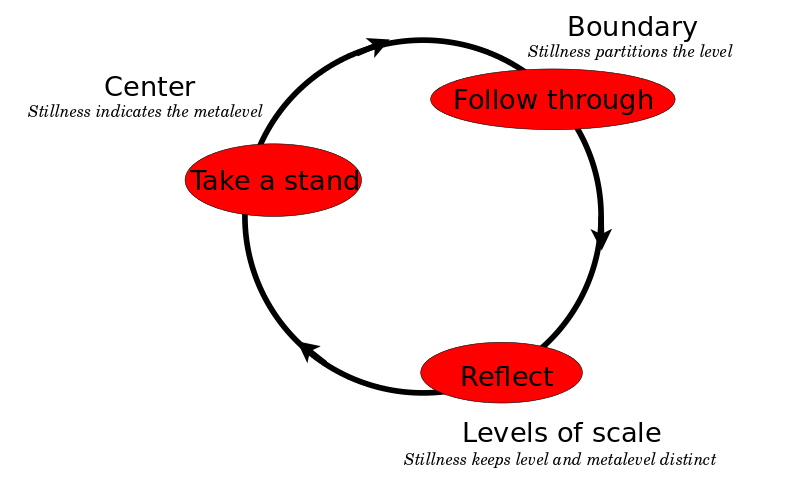
Our minds, in thinking about participation, make use of three perspectives, a cycle of taking a stand, following through and reflecting. This cycle is the basis for the scientific method: affirming a hypothesis, testing it with an experiment, appraising the results, and then affirming a new, improved hypothesis.
In living this cycle, and being perfected by it, we exhibit a perfect stillness which may be deep within us or may be far beyond us. This stillness is what defines a center as such. For example, the center of the earth is the point to which it gravitates, but also the axis along which it rotates. Stillness is an invariant, and thus a sign of a metalevel higher than our own.
Centers stand out from the activity around them. And that activity distinguishes the centers from each other. The conflicting activity inevitably is separated by a boundary of stillness, like the line which separates traffic on the right and left sides of a road. There is likewise a stillness, albeit as thin as possible, which keeps level and metalevel distinct.
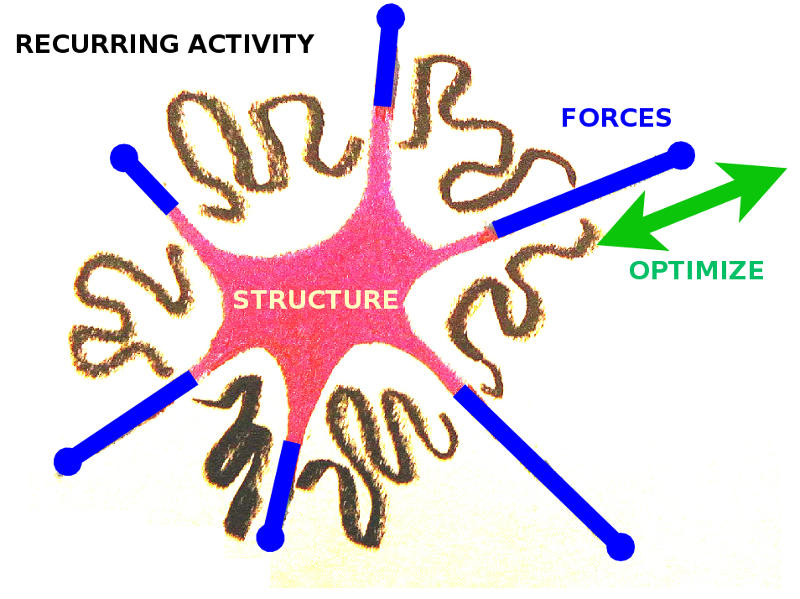
Every pattern works on four levels: recurring activity, structural solution, competing forces and optimized preferences. There are eddies of stillness within activity, a core of stillness in a structure, a web of stillness across forces, and an overall stillness in the decree of the creator. Thus we have a range of stillness, from narrow to broad, reflecting how God has gone within us and around us from beyond us.
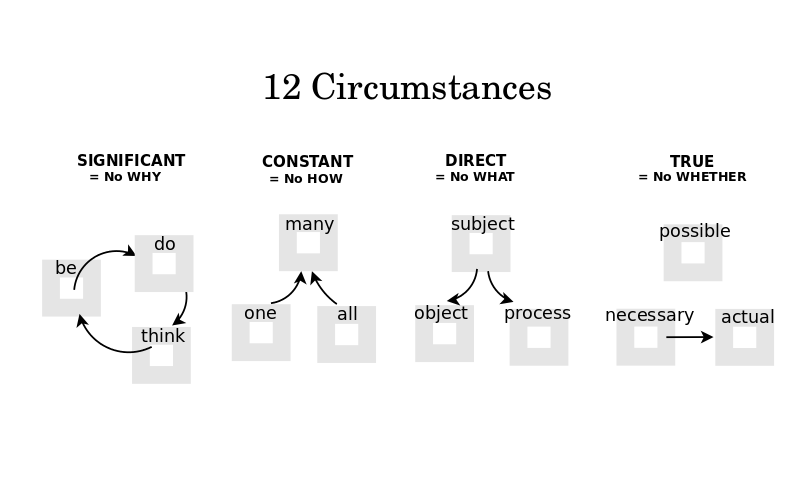
Stillness is unknowable. Grappling with stillness gives rise to 4 mind games which yield 12 circumstances, that is, 12 empty slots for our imagination to fill. They are rather similar to Kant's 12 categories.
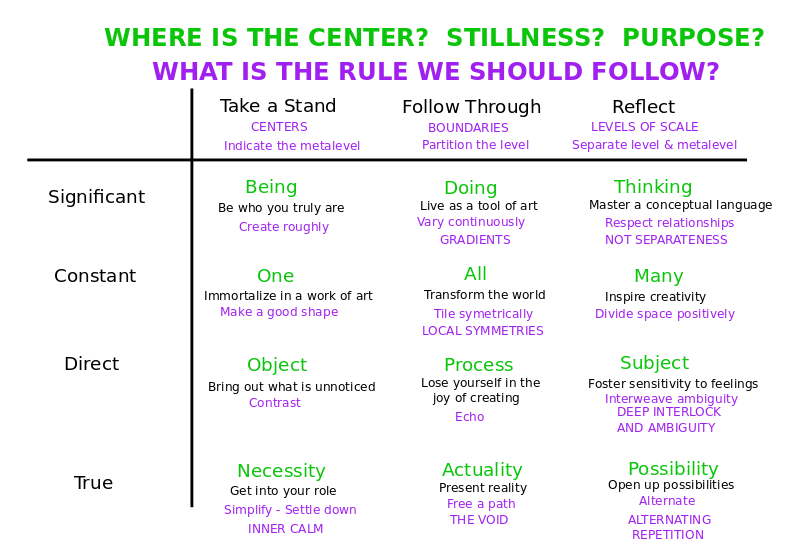
Robert Genn has collected about 100 quotes about the purpose of art. In sorting these quotes, I came up with 12 different answers. Each answer finds the purpose of art to be in one of the 12 circumstances I will present to you. And each answer inspires one of Alexander's transformations.
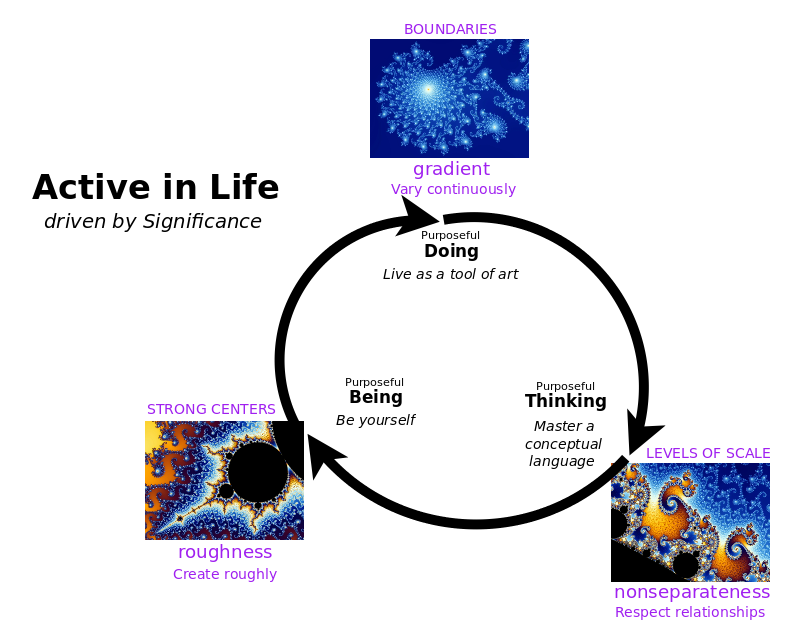
Significance is the narrowest form of stillness. No matter how immersed we are in life, we have a speck of stillness from our metalevel. In the spirit of Descartes, if thinking is significant, then being is significant, but then doing is significant, and then again thinking is significant. Our creative purpose may be to be ourselves, and so we create roughly. Or we may live as a tool of art, and so we vary continuously, yielding gradients. Or we may master a conceptual language, and so we respect relationships, and value nonseparateness.
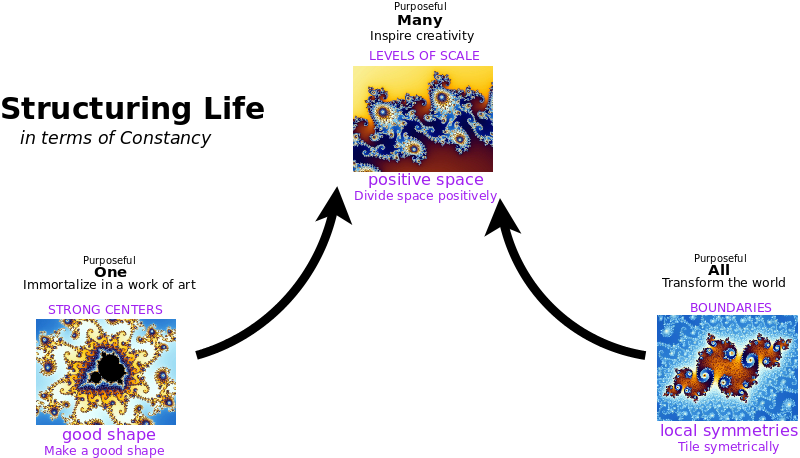
Constancy is the stillness of something, such as the core of a structure. Let us search for constancy. Either we find one example of constancy, or we don't, in which case all is constantly unconstant. And each time we select and inspect something, we suppose they stay the same, and so are multiply constant. Thus we define "one", "all" and "many" as circumstances wherein we can imagine stillness, a center, a purpose. You immortalize in a work of art by making a good shape; transform the world by tiling it symmetrically; inspire creativity by dividing space positively.
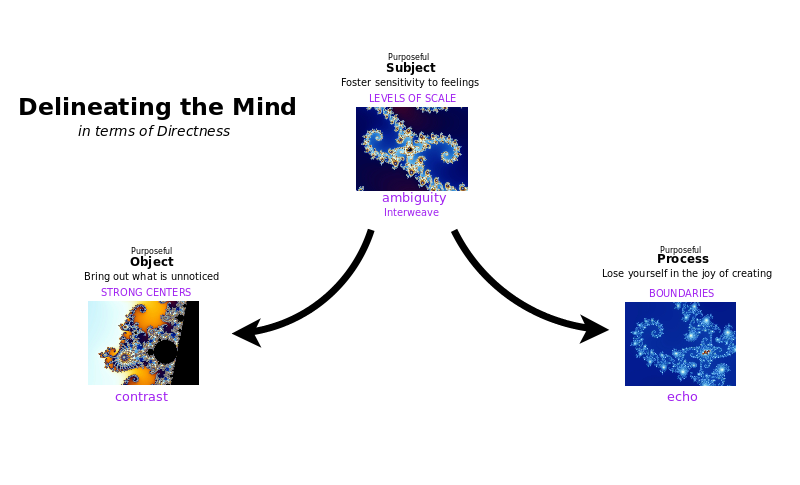
Directness is the stillness of anything, as in competing forces. Our attention can be directed to something else, an object, but then can become directed to itself, yielding a process. And a subject is the one whose attention is directed. Similarly, your bring out what is unnoticed by contrasting; you lose yourself in the joy of creating by echoing; and you foster sensitivity to feelings by interweaving, thus creating ambiguity.
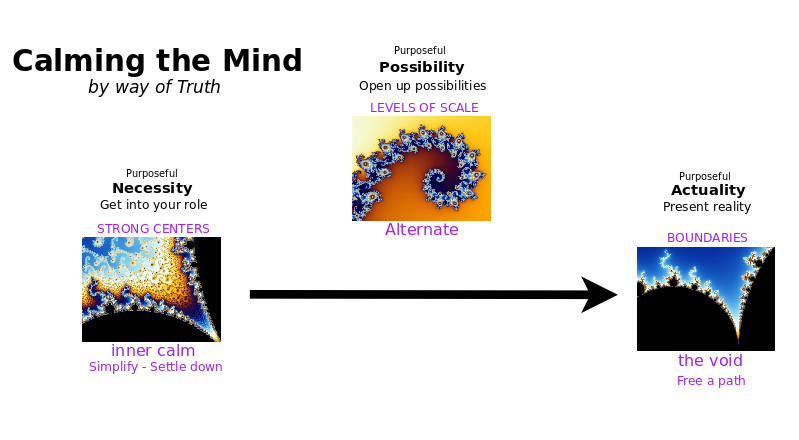
Truth is the stillness of everything. For truth is what can't be hidden, what will be revealed, what is obvious, which all makes sense in the metalevel. Truth demands that we be rational, give up our emotions and our very selves so that we can weight, without prejudice, God and the individual, what is true and what shows it to be true. If they are one and the same, then truth is necessary; if one follows from the other, then truth is actual; and if what is revealed is their relationship, then truth is possible. If your purpose is necessary, then you get into your role by simplifying; if you want to present reality, then you must free a path, opening up the void; and if you want to open up possibilities, then you alternate extremes. The formal nature of truth means that we are perfectly free to objectively compare opposites, namely, life and love, yang and yin, what is with what is not but makes room for it.
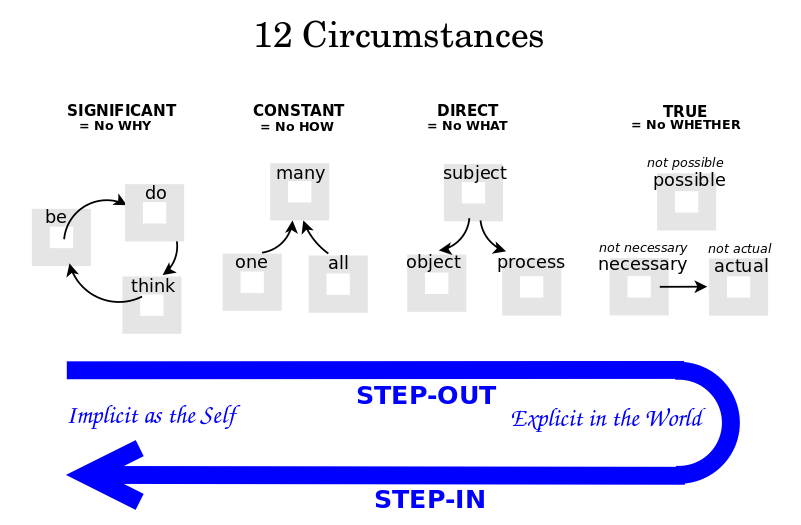
Systematizing these explorations, we are validating Alexander's intuition, but also we are clarifying what kinds of purposes we can imagine. For example, the void is not a purpose, but rather, a clearing which results upon freeing a path for the sake of presenting reality. The stillnesses of nothing, something, anything and everything allow us to think, analogously, of centers of different scope. We can imagine a God who questions whether God is necessary, and thus creates godless conditions for us and our answers. Immersed in life, we are unconsciously, emotionally driven to reject aspects of our world, to seek a higher purpose, and thus step out of ourselves and take a rational, truthful view, that of peace.
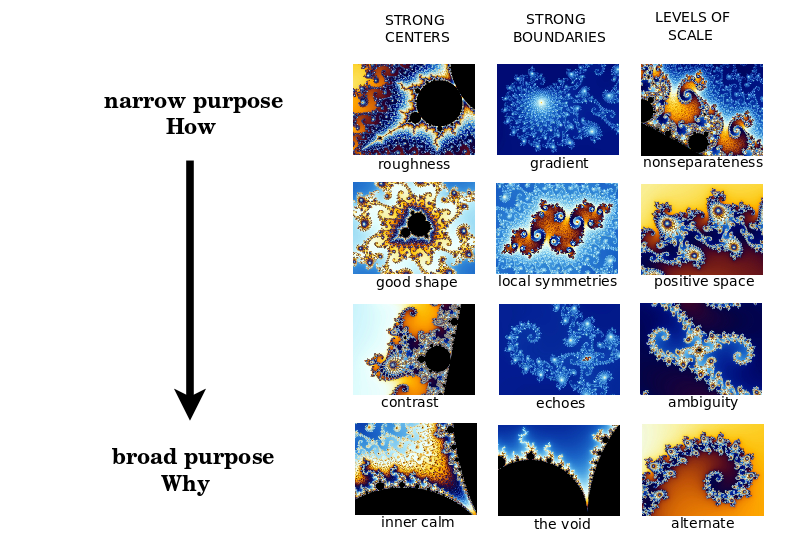
Indeed, there is a dialectic by which the narrow purpose, the How, should serve the broad purpose, the Why, and not the other way around. This is so that we rise from the level to the metalevel, that we align ourselves with God beyond us, that we find peace. For example, roughness may serve me in clearing the void to free a path to present reality, but I should not free a path for the sake of roughness. Indeed, whenever I favor the narrow stillness over the broad stillness, my unconscious riles me. Only when I flip around the How and the Why do I find peace.
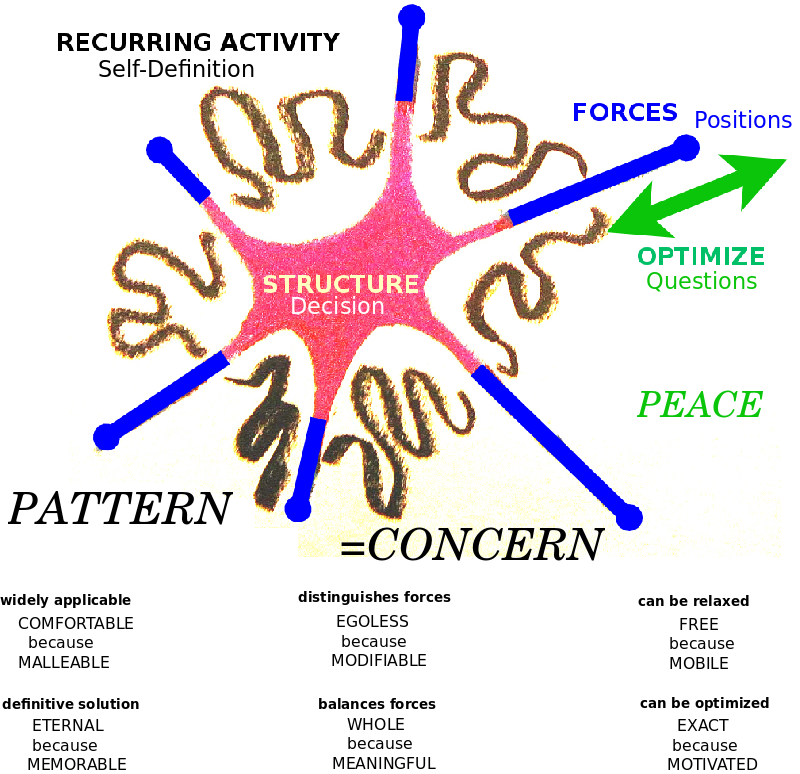
Such a lack of peace is inherent in the 6 challenges that every pattern faces. These challenges are the names which Alexander contemplates for the Quality Without a Name, which is to say, peace. Here again, I find his intuition to be comprehensive.
A pattern, as a rule of thumb, needs to be widely applicable, and thus malleable and comfortable, but on the other hand, it needs to be a definitive solution, and thus memorable and eternal. As a solution, it must distinguish forces, and thus be modifiable and egoless, but it also needs to balance those forces, and thus be meaningful and whole. As a personal, onsite implementation, it can always be relaxed, and is thus mobile and free, but it must also be optimized, so that it is motivated and exact. Thus a pattern addresses six challenges which are also the six qualities of signs, for a pattern is only a sign, an approximation by our knowledge of that which is unknowable.
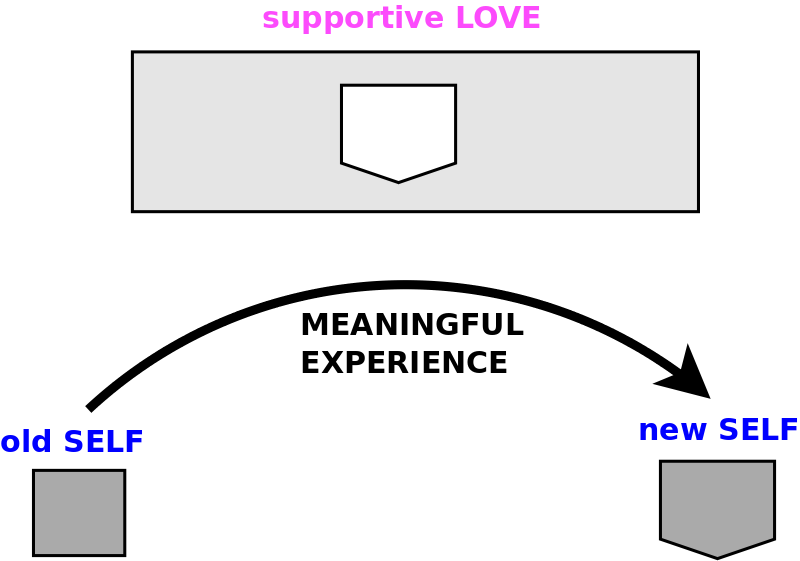
These challenges also characterize the kinds of questions by which individuals ever clarify their deepest values. And they also characterize different kinds of meaningful experiences by which we grow in life. We may ourselves not quite realize what is troubling us in life, but if somebody loves us, then we can let go of our old self and embrace a new self. Which is to say, love can nurture us when we ourselves aren't finding peace. But if we do find peace, then we can apply patterns to improve our conditions. In general, as regards to how things come to matter, I am finding that our unconscious tells us what matters emotionally, and once we step out, from the vantage view of peace, we can invest ourselves in a pattern that expresses what matters to us materially.
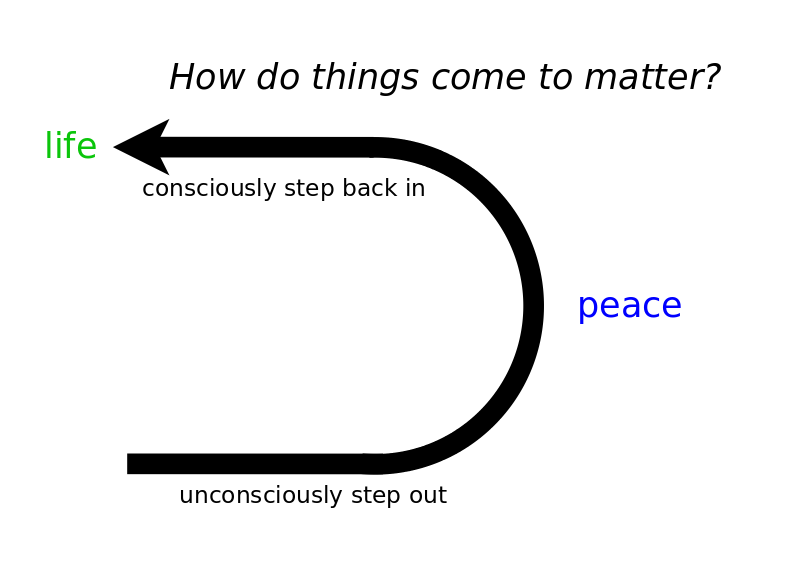
In conclusion, I gladly embrace Christopher Alexander as a genius - a poet, artist, architect and scientist. I am hopeful that his intuitive insights will give way to a rigorous science. My own investigations suggest that his Quality without a name, which he sometimes calls wholeness, would better be understood as the feeling of peace. His mystical centers may be more tangible as four kinds of stillness. His 15 properties of life could be cognitively grounded as 3 perspectives and 12 circumstances. His universal process of differentiating, which focuses on poorly defined centers, could rather address our louder feelings, whatever truly riles us. Greater emphasis could be placed on recurring activities rather than structures; on appreciating patterns as imperfect by nature; on focusing on the growth of individuals rather than changes in the environment; on the grittiness of life, by which things matter, and we ourselves learn forever, grow forever, live forever, sensitive and responsive, here and now; and on imagining God's motives. And practically, in distinguishing healthy and unhealthy patterns, we might explore as healthy those concerns which arise from real life anxieties but are resolved from the vantage of peace.
